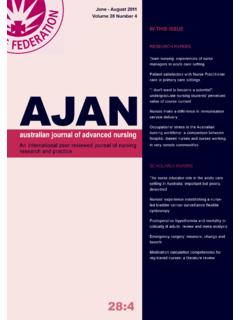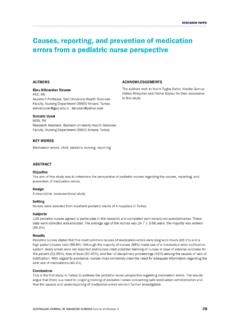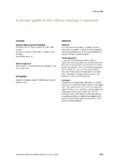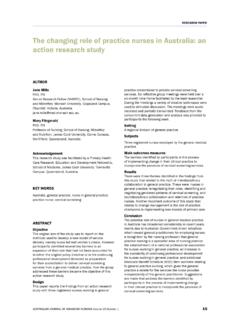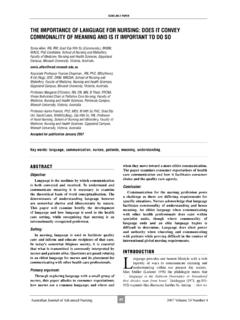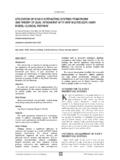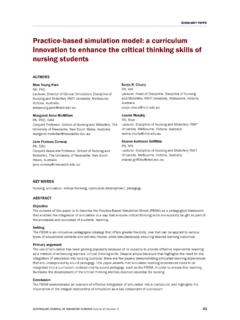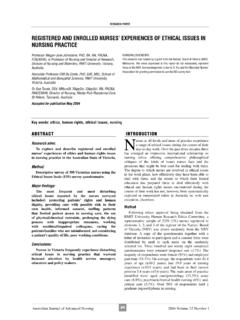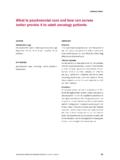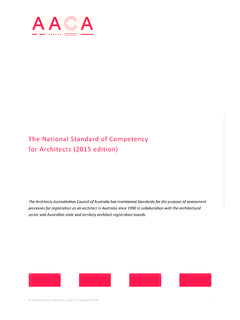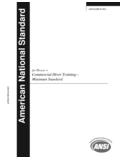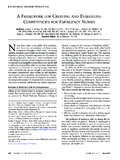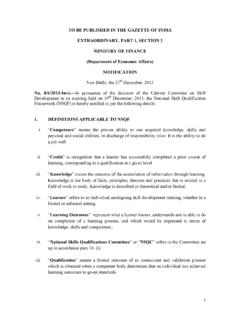Transcription of How competency standards became the preferred …
1 RESEARCH PAPER. How competency standards became the preferred national technology for classifying nursing performance in Australia AUTHOR ACKNOWLEDGEMENTS. Laurie Grealish The author wishes to acknowledge her supervisors Dr RN PhD FRCNA Anni Dugdale and Professor Barbara Pamphilon, and Associate Professor in Nursing, University of Canberra, the ACT Nursing and Midwifery Board for the research Faculty of Health, University of Canberra, ACT, Australia. grant provided. KEY WORDS. Competence, classification, history, nurse ABSTRACT. Objective The aim of this study was to explore how competency standards came to be the preferred technology for classifying and nursing performance in Australia at the end of the 20th century. Design A genealogical approach to the history of the development of the Australian Nurse Regulatory Authorities Conference (ANRAC) Competencies (1990) is adopted.
2 Setting The setting is Australia during the period of 1975 to 1990. Subjects Data was collected from minutes of ANRAC meetings, including ANRAC Competencies Committee meetings, government reports, a review of the literature on nurse assessment and competence, and interviews with five nurse leaders involved with the competencies development or regulation during this period. Main outcome measure Description of how competency standards came to be the preferred technology for classifying nursing performance in Australia. Results The emergence of a national competency standards technology is closely associated with the transfer of nursing education into the higher education sector, an expected shortage of skilled nurses, and microeconomic reform intended to position Australia as a world leader in a global economy. Through skilled rhetoric, nurse leaders established the need for national competency standards to address the issues confronting diverse social worlds while advancing the professional status of nursing through competency standards design.
3 Conclusion The national nursing competency standards is a technology that addressed the confluent concerns of those interested in the social worlds of nursing education, nursing research, occupational regulation, professional guilds, and national economic productivity thereby privileging it among instruments to classify nurse performance. AUSTRALIAN JOURNAL OF ADVANCED NURSING Volume 30 Number 2 20. RESEARCH PAPER. INTRODUCTION. The emergence of national competency standards for registered and enrolled nurses in the late 20th century was the subject of intense debate circa 1990. Today, competence and competency standards are ubiquitous in nursing, so taken for granted that competence has become a natural way of conceptualising nursing performance. In a period of less than 20 years, the classification of nursing work, and therefore nurses, into categories has become de rigueur in education and regulation, as well as in workforce management.
4 In this history of the ANRAC Competencies 1990, now known as the ANMC (2006) competency standards , aims to make visible the work of making the standards possible by describing how the ANRAC Competencies came to be the preferred technology for classifying nursing performance in Australia. LITERATURE REVIEW. In 2010, national legislation came into effect to establish and govern the Australian Health Practitioner Regulation Agency, which covers ten professions including nursing (AHPRA undated). The ANMC (2006). competency standards is one of several guidelines used by the national agency to do its work. This particular guideline has assumed significant power within Australian nursing communities, used for curriculum design;. student assessment and continuing education, including procedural competence (Dugdale and Grealish 2010).
5 Understanding the history of competency standards , and in particular how the seminal competency standards instrument was designed, can help nurses today recognise its strengths and limitations as an instrument for classifying nurse performance across a range of settings. The decision to adopt competence as an organising framework in nursing was controversial and hotly debated in the 1990s (Chapman 1999; Chambers 1998; McAllister 1998; Milligan 1998; Cheek et al 1995; Alspach 1991; Ashworth and Morrison 1991). Its ubiquity as a working concept today belies this contentious introduction. The mainstream usefulness of the competency standards is observed in the recent development of a national toolkit for determining competence in undergraduate nursing students (Crookes and Brown 2010). The search for ways to classify nurses as novice, competent, proficient, or expert or as competent/not competent is not uniquely Australian.
6 Around the world, the development of instruments to measure competence and thereby classify nursing performance, have been chiefly founded upon operational performance and/or capability (Calman et al 2002; Redfern et al 2002). In a concept analysis of competency in nursing, Tilley (2008) concluded a lack of a clear definition for competence has impeded progress towards assessment of effective practices. Bowker and Star (2000) claim that classifying work is essentially human work; it is undertaken in tacit as well as formal ways. We use categories to group materials on our desks and separate our laundry. When these classification systems are embedded in technical instruments, such as competency standards , those instruments become a black box technology; we don't have to understand how they work to use them in our daily practice.
7 But technical systems (like categorising systems) have social and political ramifications and reminding ourselves of this keeps a space open for exploration, change and flexibility (Bowker and Star 2000). In their work on theory about standards development, Star and Lampland (2009) suggest that small conventions adopted early on are both inherited and ramify throughout the system (p. 15). Understanding the conventions that underpinned the first national competency standards can help people working with the instrument today to see both its usefulness but also its limitations. This research aims to show how the competency standards came to be the preferred technology for classifying nurse performance in Australia. AUSTRALIAN JOURNAL OF ADVANCED NURSING Volume 30 Number 2 21. RESEARCH PAPER. METHOD/METHODOLOGY. Attention to the historical timing of multiple discursive elements and changes in past ones can reveal both the timing and contents of proposals for new ways to construct reality (Clarke 2005, ).
8 Analysis of discourse, focusing on a particular period in time can reveal how nursing performance came to be conceptualised as competence and competency standards rather than some other form. But some aspects of discourse never surface directly as texts therefore requiring other forms of evidence (Clarke 2005). Reviewing the iterations of instruments that pre dated the ANRAC Competencies 1990 and interviewing those who were active in the constructing work at the time can also reveal discourses that influenced the first published competency standards in 1990. The data for this study included historical documents and publications (see table 1). Literature from 1900. to 1980 was sampled in ten year periods from the collection held at the Australian national Library. The nursing literature from 1975 to 1990 was searched using key terms such as competence', assessment', and performance' and using references from other articles to identify seminal government reports.
9 The minutes of ANRAC meetings and ANRAC Competencies Committee meetings were gathered from the Australian national Library archives and the offices of the Australian Nursing and Midwifery Council. The Executive Officer of the Australian Nursing and Midwifery Council gave permission to access these documents. Table 1: Documents reviewed Nursing literature 1975 1990. Government publications 1975 1990. Minutes of ANRAC meetings 1968 1990. Minutes of ANRAC Competencies Steering Committee meetings 1988 1990. ANRAC competency standards for the Beginning Registered Nurse 1988. ANRAC competency standards for the Beginning Registered Nurse 1990. The Royal Australian Nursing Federation standards for Nursing Practice (1983). The NSW Nurses Registration Board Competencies to be Developed in College Basic Nursing Programmes (1986).
10 Notes were taken for all documents, journal articles and reports. The author was peripherally involved as a member of a state regulatory board during some of this period and therefore reflexive comments were notated as well. The first two iterations of the national competency standards published in 1988 and 1990 as well as two competency based instruments identified in the ANRAC minutes as precursors to the ANRAC Competencies, were reviewed. In depth interviews were held with five nurse leaders who participated in competency development at some point during the study period. The University's Human Ethics Committee approved the methods for interviews. During the interviews notes were recorded about the social and political milieu as the informant recalled it, and these notes were later transcribed into a report. The transcribed report was forwarded to the informant for validation and then included in the study as data.
